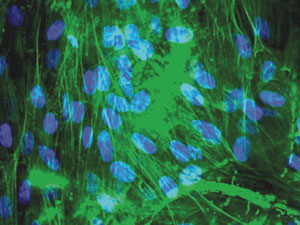
Laser scanning confocal microscopic micrograph of cells grown on polycaprolactone/(poly(3-hexylthiophene)
Scientists from Singapore have combined a photovoltaic polymer with a biocompatible polymer to make a nanofibre-based scaffold that can grow cells for skin regeneration. Although the biocompatible polymer – polycaprolactone – has been used before, the scientists say that including the photovoltaic polymer leads to a higher proliferation of cells on the scaffold.
‘Skin tissue-engineering involves the use of scaffolds that support cell attachment and proliferation, together with the formation of skin tissue-like structure to substitute the skin,’ say Molamma Prabhakaran, Seeram Ramakrishna and colleagues from the National University of Singapore, who carried out the research.
Read the full article in Chemistry World
Link to journal article
Electrospun photosensitive nanofibers: Potential for photocurrent therapy in skin regeneration
M P Prabhakaran et al
Photochem. Photobiol. Sci., 2012, DOI: 10.1039/c2pp25070e










